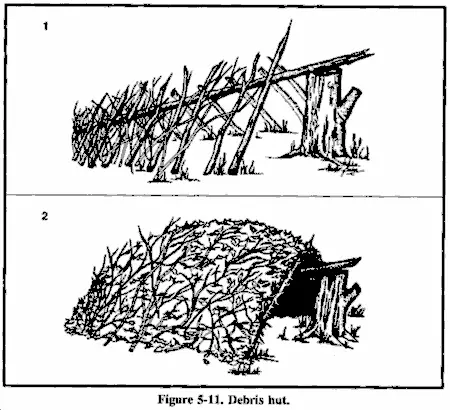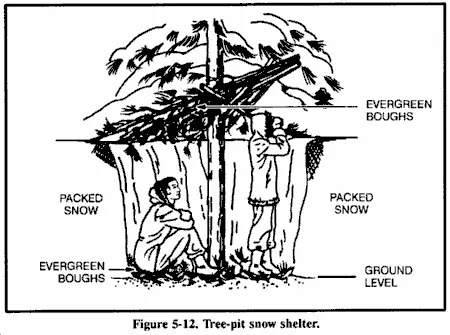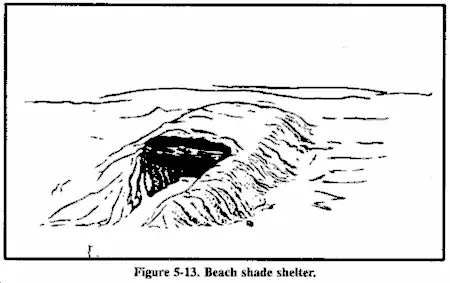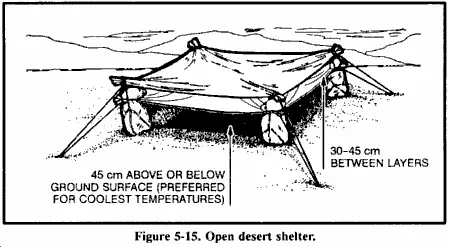• Stay away from low ground such as ravines, narrow valleys, or creek beds. Low areas collect the heavy cold air at night and are therefore colder than the surrounding high ground. Thick, brushy, low ground also harbors more insects.
• Check for poisonous snakes, ticks, mites, scorpions, and stinging ants.
• Look for loose rocks, dead limbs, coconuts, or other natural growth than could fall on your shelter.
Debris Hut
For warmth and ease of construction, this shelter is one of the best. When shelter is essential to survival, build this shelter.
To make a debris hut (Figure 5-11)-
• Build it by making a tripod with two short stakes and a long ridgepole or by placing one end of a long ridgepole on top of a sturdy base.
• Secure the ridgepole (pole running the length of the shelter) using the tripod method or by anchoring it to a tree at about waist height.
• Prop large sticks along both sides of the ridgepole to create a wedge-shaped ribbing effect. Ensure the ribbing is wide enough to accommodate your body and steep enough to shed moisture.
• Place finer sticks and brush crosswise on the ribbing. These form a latticework that will keep the insulating material (grass, pine needles, leaves) from falling through the ribbing into the sleeping area.
• Add light, dry, if possible, soft debris over the ribbing until the insulating material is at least 1 meter thick--the thicker the better.
• Place a 30-centimeter layer of insulating material inside the shelter.
• At the entrance, pile insulating material that you can drag to you once inside the shelter to close the entrance or build a door.
• As a final step in constructing this shelter, add shingling material or branches on top of the debris layer to prevent the insulating material from blowing away in a storm.

Tree-Pit Snow Shelter
If you are in a cold, snow-covered area where evergreen trees grow and you have a digging tool, you can make a tree-pit shelter (Figure 5-12).

To make this shelter-
• Find a tree with bushy branches that provides overhead cover.
• Dig out the snow around the tree trunk until you reach the depth and diameter you desire, or until you reach the ground.
• Pack the snow around the top and the inside of the hole to provide support.
• Find and cut other evergreen boughs. Place them over the top of the pit to give you additional overhead cover. Place evergreen boughs in the bottom of the pit for insulation.
See Chapter 15 for other arctic or cold weather shelters.
Beach Shade Shelter
This shelter protects you from the sun, wind, rain, and heat. It is easy to make using natural materials.
To make this shelter (Figure 5-13)-
• Find and collect driftwood or other natural material to use as support beams and as a digging tool.
• Select a site that is above the high water mark.
• Scrape or dig out a trench running north to south so that it receives the least amount of sunlight. Make the trench long and wide enough for you to lie down comfortably.
• Mound soil on three sides of the trench. The higher the mound, the more space inside the shelter.
• Lay support beams (driftwood or other natural material) that span the trench on top of the mound to form the framework for a roof.
• Enlarge the shelter's entrance by digging out more sand in front of it.
• Use natural materials such as grass or leaves to form a bed inside the shelter.

Desert Shelters
In an arid environment, consider the time, effort, and material needed to make a shelter. If you have material such as a poncho, canvas, or a parachute, use it along with such terrain features as rock outcropping, mounds of sand, or a depression between dunes or rocks to make your shelter.
Using rock outcroppings-
• Anchor one end of your poncho (canvas, parachute, or other material) on the edge of the outcrop using rocks or other weights.
• Extend and anchor the other end of the poncho so it provides the best possible shade
in a sandy area-
• Build a mound of sand or use the side of a sand dune for one side of the shelter.
• Anchor one end of the material on top of the mound using sand or other weights
• Extend and anchor the other end of the material so it provides the best possible shade.
Note: If you have enough material, fold it in half and form a 30-centimeter to 45-centimeter airspace between the two halves. This airspace will reduce the temperature under the shelter.
A belowground shelter (Figure 5-14) can reduce the midday heat as much as 16 to 22 degrees C (30 to 40 degrees F). Building it, however, requires more time and effort than for other shelters. Since your physical effort will make you sweat more and increase dehydration, construct it before the heat of the day.

To make this shelter-
• Find a low spot or depression between dunes or rocks. If necessary, dig a trench 45 to 60 centimeters deep and long and wide enough for you to lie in comfortably.
• Pile the sand you take from the trench to form a mound around three sides.
• On the open end of the trench, dig out more sand so you can get in and out of your shelter easily.
• Cover the trench with your material.
• Secure the material in place using sand, rocks, or other weights.
If you have extra material, you can further decrease the midday temperature in the trench by securing the material 30 to 45 centimeters above the other cover. This layering of the material will reduce the inside temperature 11 to 22 degrees C (20 to 40 degrees F). Another type of belowground shade shelter is of similar construction, except all sides are open to air currents and circulation. For maximum protection, you need a minimum of two layers of parachute material (Figure 5-15). White is the best color to reflect heat; the innermost layer should be of darker material.

Chapter 6.
Water Procurement
Table of Contents
 Water is one of your most urgent needs in a survival situation. You can' t live long without it, especially in hot areas where you lose water rapidly through perspiration. Even in cold areas, you need a minimum of 2 liters of water each day to maintain efficiency. More than three-fourths of your body is composed of fluids. Your body loses fluid as a result of heat, cold, stress, and exertion. To function effectively, you must replace the fluid your body loses. So, one of your first goals is to obtain an adequate supply of water. Water is one of your most urgent needs in a survival situation. You can' t live long without it, especially in hot areas where you lose water rapidly through perspiration. Even in cold areas, you need a minimum of 2 liters of water each day to maintain efficiency. More than three-fourths of your body is composed of fluids. Your body loses fluid as a result of heat, cold, stress, and exertion. To function effectively, you must replace the fluid your body loses. So, one of your first goals is to obtain an adequate supply of water. |
Конец ознакомительного фрагмента.
Читать дальше






 Water is one of your most urgent needs in a survival situation. You can' t live long without it, especially in hot areas where you lose water rapidly through perspiration. Even in cold areas, you need a minimum of 2 liters of water each day to maintain efficiency. More than three-fourths of your body is composed of fluids. Your body loses fluid as a result of heat, cold, stress, and exertion. To function effectively, you must replace the fluid your body loses. So, one of your first goals is to obtain an adequate supply of water.
Water is one of your most urgent needs in a survival situation. You can' t live long without it, especially in hot areas where you lose water rapidly through perspiration. Even in cold areas, you need a minimum of 2 liters of water each day to maintain efficiency. More than three-fourths of your body is composed of fluids. Your body loses fluid as a result of heat, cold, stress, and exertion. To function effectively, you must replace the fluid your body loses. So, one of your first goals is to obtain an adequate supply of water.










